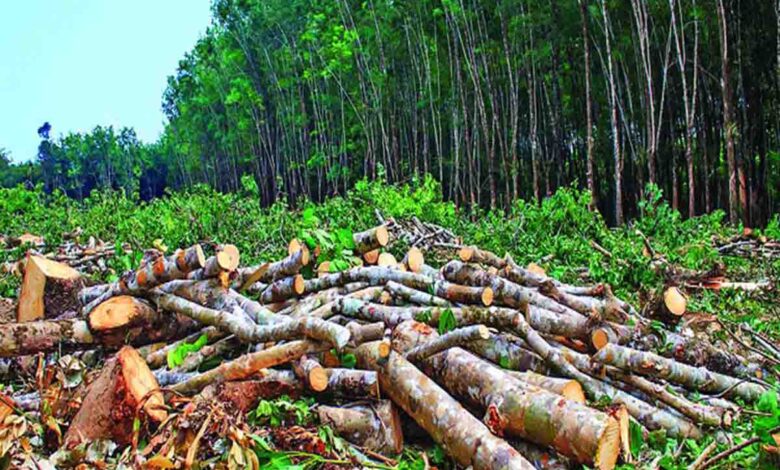Ecological coup d’état is imminent!

Monday, 23 February 2023 | Vir Singh
GUEST COLUMN
 Vir Singh
Vir Singh
The world’s human population has more than doubled in the past five decades but wildlife populations have declined by 69 per cent in the same period. This fact, published in the 2022 report of the World Wildlife Fund (WWF), reflects the imminence of an ecological coup on Earth. According to WWF’s latest Living Planet report, the number of species including mammals, birds, amphibians, reptiles and fish has declined the most between 1970 and 2018. India is also not untouched by the consistent wipeout of wildlife.
Human-caused events as well as climate change are behind the continuing sharp decline in wildlife populations. The report states, “Increasing temperatures are already increasing the incidence of mass mortality, as well as becoming the primary cause of extinction of all living species. For each degree Celsius increase in temperature, such life losses and human impact are likely to increase.”
According to WWF-India programme director Sejal Worah, the country has witnessed a decline in the population of 17 species of bees and freshwater turtles during this period. According to her, the report found that the Himalayan region and the Western Ghats are some of the most vulnerable areas in the country in terms of biodiversity loss, where this loss is likely to increase in the future as temperatures rise. “Recent projects such as cheetah translocations are good examples of wildlife conservation and India has seen successes such as Project Tiger and the conservation of one-horned rhinos and lions,” says WWF-India secretary general Ravi Singh. Conservation has an umbrella effect on all other species living in that habitat.
The biennial report, published by the Zoological Society of London, outlines how wildlife is facing increasing pressure from declining biodiversity and climate change. Latin America and the Caribbean have seen the largest declines in globally monitored wildlife populations- an average decline of 94 per cent between 1970 and 2018. During the same period, monitored populations in Africa declined by 66 per cent while those in Asia Pacific recorded a 55 per cent decline.
WWF has found that populations of freshwater animals have declined the most- an average decline of 83 per cent between 1970 and 2018. The IUCN Red List shows that cycads – an ancient group of seed plants – are the most threatened species, while coral reefs are declining the fastest followed by amphibians.
WWF has found that populations of freshwater animals have declined the most- an average decline of 83 per cent between 1970 and 2018. The IUCN Red List shows that cycads – an ancient group of seed plants – are the most threatened species, while coral reefs are declining the fastest followed by amphibians.
The main reason for the decline of wildlife populations around the world is the degradation and exploitation of their natural habitats, especially forests. Invasive species of plants and animals are encroaching on the natural habitats of wildlife, depriving native wildlife of sufficient food and on top of that, they are preyed upon by invasive animals. Pollution, climate change and diseases are other factors that devastate wildlife populations. Land-use change is still the biggest present-day threat to nature as economic activities continue to expand at an unabated pace. Most of the natural environments, such as natural forests, which were the original habitat of animals, have been transformed to give way to the development of agricultural land, industrial areas, roads, tourist places, and human settlements. The most precious resource is land and economic development has become the focal point of its utilisation. If we are unable to limit global warming to 1.5°C, climate change will likely be the leading cause of biodiversity loss in the coming decades. For example, about 50 per cent of corals have already vanished as seawater warms, and 70–90 per cent of warm-water corals will also face total extinction with a warming of 1.5 °C.
The report also revealed that mangroves are being harvested at the rate of 0.13 per cent per year under aquaculture, agriculture and coastal development programmes. Many mangroves are destroyed by natural causes such as storms and coastal erosion, as well as by overexploitation and pollution. Mangroves are very important natural habitats for biodiversity conservation and also represent ecosystem services for coastal communities. Many socio-economic needs of the coastal communities are met by the mangrove ecosystem. For example, 137 kms of the Sundarbans mangrove forest has been destroyed since 1985, reducing land and ecological services for nearly the 10 million people who live there.
Clean and serene streams are a natural source of habitat for a variety of living organisms. But only 37 per cent of rivers that are longer than 1,000 kms remain free-flowing. The rest of the rivers in India are no longer in a free-flowing state. When the ever-flowing rivers get polluted and their flow gets blocked, then the existence of several species growing inside it starts ending.
Geographically, Southeast Asia remains the region where species are most likely to face multiple extinction threats, while the polar regions and the east coasts of Australia and South Africa are likely to have the highest impact potential for climate change. Such adverse impacts are especially visible in birds. The biodiversity of nature is the basis of sustainability and prosperity of life on the living planet. Wildlife is one of the most important links of natural diversity. If the population of wildlife continues to shrink, their ecological environment continues to be plundered and destroyed, and species continue to take the path of extinction, then a sort of ecological coup d’état on the planet is imminent. If the protection of wildlife, and for that, the protection and expansion of their natural habitats are central to our socio-economic development plans, then only we will be paving the way for our sustainable development.
(The author is professor emeritus of environmental science, GB Pant University of Agriculture and Technology. Views expressed are personal)






